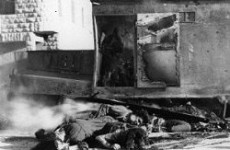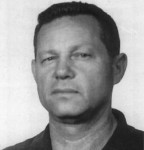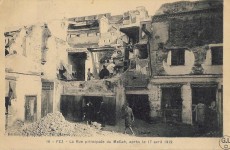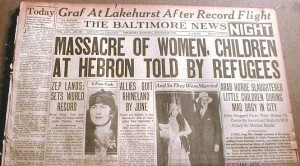
The Hebron Massacre refers to the mass murder of 67 Jews on 23 and 24 August 1929 in Hebron, then part of the British Mandate of Palestine, by Arabs incited to violence by false rumors that Jews were massacring Arabs in Jerusalem and seizing control of Muslim Holy Places.
Hebron, located 30 kilometers south of Jerusalem, is the second holiest among the Four Holy Cities of Judaism, and is revered by Muslims as well. It is home to the Cave of Machpelah, the burial place of Abraham. It is also the site where where the Biblical David was anointed King of Israel and continued to reign until his capture of Jerusalem. A Jewish Sephardic community has lived there continuously for over 800 years under various imperial powers, and the Ashkenazi community also has roots there going back at least more than a century.
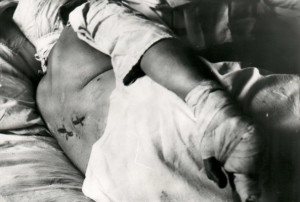
In the early 20s’, periods of Arab harassment, involving cursing on the street, occasional beatings, and rocks through windows, would occasionally disturb what was, in many accounts, an otherwise amicable relationship between the Hebron Jewish and Arab communities. For some time, the 800 Jews in Hebron lived in peace with their tens of thousands of Arab neighbors. But on the night of August 23, 1929, the tension simmering within this cauldron of nationalities bubbled over, and for 3 days, Hebron turned into a city of terror and murder. By the time the massacres ended, 67 Jews lay dead and the survivors were forced to flee to Jerusalem. Leaving Hebron barren of Jews for the first time in hundreds of years until after the Six-Day War of 1967,It also led to the re-organization and development of the Jewish defense organization, the Haganah, which later became the nucleus of the Israel Defense Forces.
Sequence of events
-
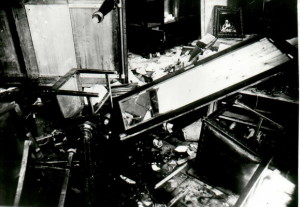
Ruins after the massacre in Hebron 1929 On Friday, 23 August, inflamed by rumors that Jews were about to attack al-Aqsa Mosque, Arabs started to attack Jews in the Old City of Jerusalem. The rumors and subsequent violence quickly spread to other parts, with the worst killings occurring in Hebron and Saved. Other murderous assaults took place in Motza, Kfar Uriyah, and Tel Aviv.
- That day, the tranquility in Hebron was lost. Arab youths started throwing rocks at the yeshiva students. That afternoon, one student, Shmuel Rosenholtz, went to the yeshiva alone. Arab rioters later broke in and killed him, and that was only the beginning.
- Friday night, Rabbi Ya’acov Slonim’s son invited any fearful Jews to stay in his house. The rabbi was highly regarded in the community. Many Jews took him up on this offer, and many Jews were eventually murdered there.
-
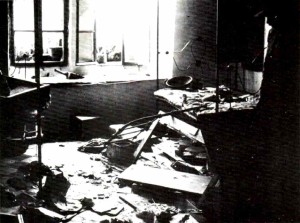
Ruins after the massacre in Hebron 1929 As early as 8:00 a.m. on Saturday, the Jewish Sabbath, Arabs began to gather en masse. They came in mobs, armed with clubs, knives and axes. While the women and children threw stones, the men ransacked Jewish houses and destroyed Jewish property. With only a single police officer in Hebron, the Arabs entered Jewish courtyards with no opposition.
- Rabbi Slonim, who had tried to shelter the Jewish population, was approached by the rioters and offered a deal: If all the Ashkenazi yeshiva students were given over to the Arabs, the rioters would spare the lives of the Sephardi community. Rabbi Slonim refused to turn over the students and was killed on the spot. In the end, 12 Sephardi Jews and 55 Ashkenazi Jews were murdered. Most of dead were Ashkenazi men, but there were also a dozen women and three children under the age of three. Seven of the victims were yeshiva students from the United States and Canada. Dozens of people were wounded, including many women and children. Several cases of rape, mutilation and torture were reported.
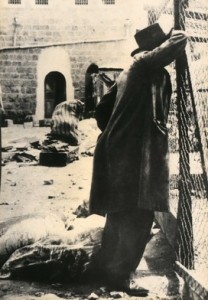
Many Jews survived by hiding in their Arab neighbors’ houses, while others survived by taking refuge in the British police station at Beit Romano on the outskirts of the city. The surviving Jews were later were forced to evacuate to Jerusalem. One third of the people murdered were students of the Hebron yeshiva. After the massacre, the remainder of the yeshiva was also moved to Jerusalem.
When Jews finally gained control of the city in 1967, a small number of massacre survivors again tried to reclaim their old houses. Then defense minister, Moshe Dayan, supposedly told the survivors that if they returned they would be arrested, and that they should be patient while the government worked out a solution to get their houses back. Years later, settlers moved to parts of Hebron without the permission of the government, but for those massacre survivors still seeking their original homes, that solution never came.


